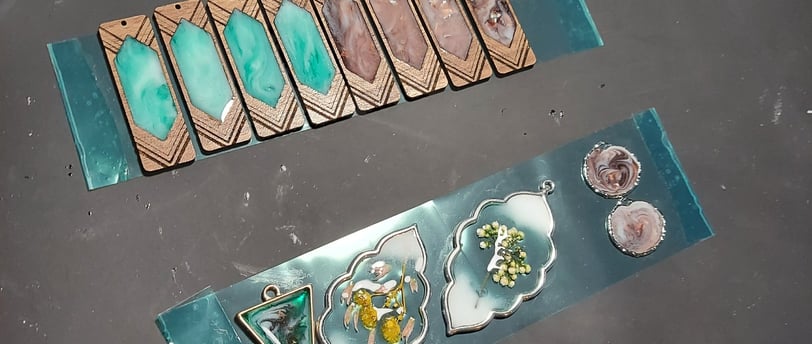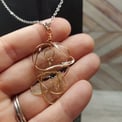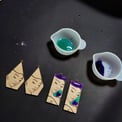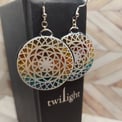Free Shipping on orders over $50
Exploring the World of Resins in Jewelry and Crafts
9/7/20245 min read


Introduction to Resins: What You Need to Know
Resins are fascinating materials that have gained prominence in the fields of jewelry-making and crafts. Originating from both natural and synthetic sources, these versatile substances can be utilized to create an array of artistic designs and functional objects. Natural resins, like those derived from tree sap, have been used for thousands of years for their aesthetic qualities and durability, while synthetic resins have emerged as reliable alternatives, allowing for increased creativity and innovation.
In their most basic form, resins are viscous substances that can be transformed into solid materials upon curing. This transformation occurs through chemical reactions, leading to a variety of properties that can be manipulated based on the intended application. The ability to customize hardness, color, and clarity makes resins particularly appealing to artisans. As a result, crafters often incorporate resins into their work to achieve unique designs and enhance the overall presentation of their creations.
The significance of resins in crafting is not solely limited to their physical properties. They embody a growing trend among artists and makers who appreciate the eco-friendly options available. Many individuals are drawn to the sustainable aspects of using plant-based resins, which offer an alternative to plastic-derived materials. Furthermore, the innovative methods available for mixing and modeling resins facilitate an endless array of designs, from intricate jewelry pieces to larger decorative items.
Resins are becoming increasingly popular, thanks in part to the expanding online community of crafters sharing their techniques and projects. Tutorials and resources empower both novice and experienced artisans to explore the diverse potential of this material. Whether for jewelry or functional art pieces, resins are redefining the landscape of crafting and offer infinite possibilities to those willing to experiment.
Types of Resins: Understanding the Options
When it comes to crafting with resins, understanding the various types available is essential for achieving excellent results in your jewelry and craft projects. The four most common types of resins are epoxy, polyester, polyurethane, and UV resin, each with its distinct properties, advantages, and ideal applications.
Epoxy resin is renowned for its versatility and high durability. It consists of two components, a resin and a hardener, which, when mixed together, undergo a chemical reaction that creates a hard, resistant surface. Epoxy is particularly favored in jewelry making due to its clarity and high-gloss finish, making it an excellent choice for encapsulating items such as flowers or photographs. Its resistance to yellowing and excellent adhesion properties make it suitable for both professional and amateur artisans.
Polyester resin, on the other hand, is generally less expensive and faster to cure than epoxy. Its chemical structure allows for a variety of colors and finishes, making it appealing for crafting decorative items. However, polyester resin has a stronger odor and can be more brittle. This type is typically used in casting and sometimes for laminating projects, although it may require additional coatings to protect from UV degradation.
Polyurethane resin is notable for its flexibility and toughness. It can be formulated to be either rigid or flexible, making it a great choice for a variety of applications, from jewelry to functional items like grips and seals. Its resilience against impact and abrasion allows for innovative projects that require durable solutions.
Lastly, UV resin has gained popularity for its ease of use. It cures quickly under ultraviolet light, making it ideal for small crafts and jewelry pieces. The clarity and gloss of UV resin are excellent, but users should ensure proper exposure to UV light for complete curing. This type is especially favored by crafters who appreciate fast turnaround times.
By familiarizing yourself with these types of resins, you can select the most suitable option for your specific crafting project, ensuring both aesthetic appeal and functionality in your creations.
Pros and Cons of Working with Resins
When delving into the world of resins for jewelry and crafts, it is essential to understand both the advantages and challenges associated with this versatile medium. One of the most notable benefits of resin is its durability. Finished products, such as jewelry pieces, exhibit impressive resilience, making them suitable for everyday wear. This longevity is complemented by the aesthetic appeal of resin, which can mimic the appearance of glass or gemstone, presenting creators with a wide array of visual possibilities.
Furthermore, customization options with resins are abundant. Crafters can incorporate various pigments, inclusions, and molds to achieve unique designs that reflect their personal style. This potential for creativity allows artists to push boundaries, transforming resin into a canvas for their visions. From vibrant colors to intricate layering, the possibilities are virtually limitless, fostering innovation in the crafting process.
However, while working with resins can be rewarding, several challenges must be considered. Health and safety are paramount, as many resin products may release hazardous fumes during mixing and curing. It is crucial for makers to use appropriate personal protective equipment (PPE) and work in well-ventilated areas to mitigate potential risks. Additionally, the curing times associated with resins can vary significantly, often requiring patience and careful planning to ensure optimal results.
Moreover, beginners may encounter a steep learning curve when mastering resin techniques. Variations in temperature and humidity can greatly affect the outcome, leading to common issues such as bubbles or improper curing. As such, new crafters should invest time in research and practice to cultivate their skills. Ultimately, weighing the pros and cons of working with resins will empower artists to make informed decisions as they embark on their crafting journeys.
Creative Ideas for Resin Projects
Resin is a remarkably versatile medium that opens a world of creative possibilities for jewelry and crafts. Artists and crafters alike can explore an array of project ideas that showcase the unique properties of resin, allowing for stunning artistic expression. One popular application of resin is in creating custom jewelry pieces. Crafting pendants, earrings, and bracelets using resin enables the incorporation of various materials such as flowers, glitter, and beads. By embedding these elements, one can achieve a personal touch, resulting in exquisite and conversation-worthy accessories.
In addition to jewelry, resin can also be utilized to create decorative items that enhance home décor. Coasters, trays, and wall art are excellent examples of how resin can be transformed into functional and aesthetically pleasing objects. For instance, coasters made from resin can incorporate colorful pigments or even photographs, protecting surfaces while complementing interior designs. Moreover, resin allows for various techniques, such as layering and marbling, which adds depth and visual interest to decorative pieces.
Mixed media art enthusiasts can also benefit from the capabilities of resin. Combining resin with other materials, such as wood, canvas, or fabric, enables artists to explore new textures and aesthetic combinations. The use of resin as a topcoat can enhance artwork, providing a glossy finish that protects against wear and tear while amplifying colors. This fusion of materials can lead to truly innovative creations that challenge traditional boundaries of art.
Lastly, functional crafts, such as keychains, bookmarks, and phone cases, can also be enriched with resin. These projects not only serve a purpose but can also reflect individuality through custom designs. The potential for customization combined with the durable nature of resin makes it an ideal medium for everyday items. With so many possibilities, the world of resin projects remains abundant and inspiring.






